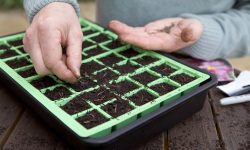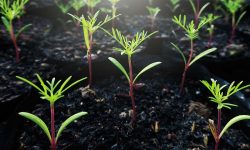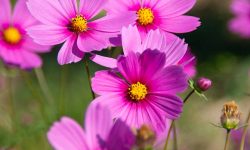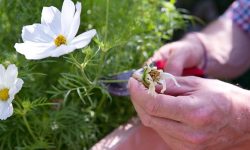Zinnias are among the most cheerful and rewarding flowers to grow, bringing a burst of color to any garden with minimal effort. Their daisy-like blooms in shades of pink, orange, red, and yellow can transform even the simplest patch of soil into a radiant display. But the key to achieving those endless summer blooms lies in knowing exactly when to sow zinnia seeds. Timing affects everything—from how quickly they germinate to how long they continue to flower through the warm months.
This guide reveals the best time to sow zinnia seeds based on climate, growing conditions, and gardening goals. You’ll learn how to start them indoors, when to direct sow outdoors, and how to extend their blooming season until fall. Whether you’re an experienced gardener or just beginning, mastering the right sowing time ensures your zinnias thrive with strong stems, abundant blooms, and vibrant color that lasts all season long.
Understanding Zinnia Growth and Climate Needs
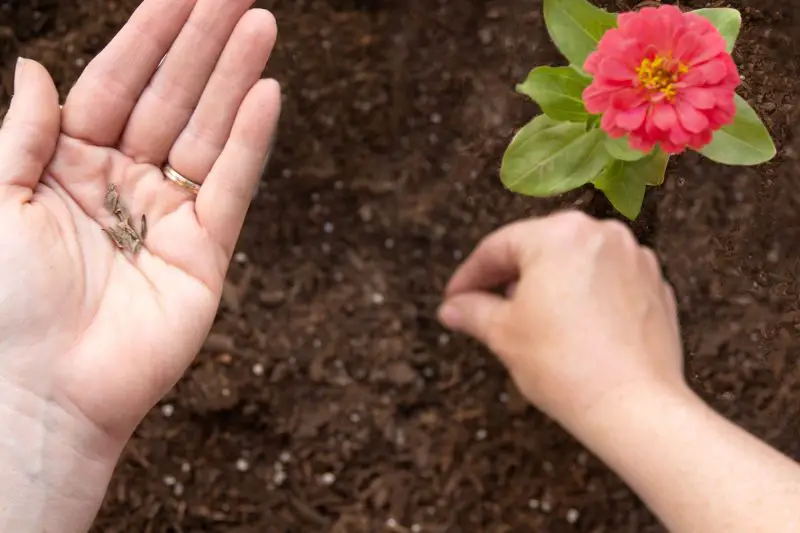
Zinnias thrive in warm weather and love full sun. These annual flowers complete their life cycle within one season, making timing a vital factor for success. They grow best in temperatures between 70°F and 85°F, which allows their seeds to germinate quickly and their roots to establish firmly. When planted too early, cold and damp conditions can cause poor germination or rot, while late planting can shorten the blooming period. Understanding your local climate and frost schedule is essential to determine when to sow zinnia seeds for continuous summer color.
Zinnias are native to warm regions of Mexico and the southwestern United States, which explains their preference for heat and sunlight. They need at least six hours of direct sunlight daily to produce sturdy stems and large, colorful blossoms. In cooler areas, gardeners often start zinnia seeds indoors to give them a head start before the outdoor temperatures stabilize. In warmer regions, direct sowing after the danger of frost has passed is often the best choice. Both approaches work well, provided the temperature and soil conditions are suitable for strong seedling growth.
Humidity and soil drainage also play significant roles in how zinnias grow. These flowers dislike overly wet soil, which can lead to fungal issues or root rot. Instead, they prefer well-draining soil that allows roots to breathe while retaining enough moisture for steady development. In areas with high humidity, providing good air circulation between plants helps reduce disease. With the right balance of warmth, sunlight, and moisture, zinnias can quickly mature into vigorous plants covered in brilliant blooms that last through the summer.
Best Time to Sow Zinnia Seeds by Region
The timing for sowing zinnia seeds varies depending on where you live, as temperature and frost patterns differ across regions. In warm southern climates, such as zones 9–11, zinnias can be sown directly outdoors as early as late March or early April when the soil warms above 65°F. The long growing season in these areas allows for multiple successions of planting, ensuring continuous blooms well into fall. Gardeners in these regions can even start seeds indoors in late winter for an earlier burst of color, transplanting them once the soil is consistently warm.
In temperate or midrange climates like zones 6–8, the ideal time to sow zinnia seeds is from mid-April to late May, depending on the last frost date. Starting seeds indoors about four weeks before the final frost ensures the plants are ready to move outdoors as soon as the weather stabilizes. Direct sowing is also possible after frost, but the indoor start helps achieve earlier blooms. Since zinnias prefer consistent warmth, it’s crucial to avoid planting too soon, as cold soil can delay germination and weaken seedlings. With proper timing, these areas often enjoy zinnias blooming from early summer through mid-autumn.
For cool northern climates in zones 3–5, gardeners must wait until late May or even early June to sow zinnias outdoors. Indoor sowing is highly recommended in these regions to maximize the short summer season. Starting seeds six weeks before the last frost gives the plants a solid head start. Once transplanted into the garden, zinnias quickly adapt and begin flowering by midsummer. Despite the shorter season, these regions can still enjoy weeks of radiant blooms with careful timing and adequate warmth.
Starting Zinnia Seeds Indoors for Early Blooms
Starting zinnia seeds indoors allows gardeners to enjoy flowers earlier in the season and gives seedlings a head start before outdoor temperatures rise. The best time to begin indoor sowing is about four to six weeks before your region’s last expected frost date. This schedule ensures the seedlings are mature enough to transplant once the soil warms above 65°F. Use seed trays or small pots filled with light, well-draining seed-starting mix. Sow the seeds about a quarter-inch deep, lightly cover them with soil, and mist them with water to keep the surface moist but not soggy. Within five to ten days, healthy green shoots usually appear under warm, bright conditions.
Providing the right indoor environment is essential for strong growth. Zinnia seedlings thrive under bright light—preferably near a sunny window or under grow lights positioned about two inches above the seedlings. Consistent warmth between 70°F and 75°F promotes vigorous root development and prevents leggy stems. It’s important to maintain steady airflow to prevent damping-off disease, a common issue in overly humid or stagnant air. A small fan on a gentle setting helps strengthen the young plants while reducing moisture buildup on leaves. Water only when the top of the soil feels dry, and avoid overwatering to keep the roots healthy.
After about three to four weeks, the seedlings should be several inches tall and ready for hardening off. This process involves gradually exposing them to outdoor conditions for several hours each day, increasing exposure over a week. Once the danger of frost has passed and the soil has warmed sufficiently, the young zinnias can be transplanted outdoors. Starting indoors ensures a robust start, leading to earlier blooms and a longer flowering season throughout the summer months.
Direct Sowing Zinnia Seeds Outdoors
Direct sowing zinnia seeds outdoors is one of the easiest and most rewarding ways to grow these vibrant flowers. Once the danger of frost has completely passed and the soil temperature reaches at least 65°F, you can safely begin planting. Choose a sunny location that receives at least six hours of direct sunlight each day, as zinnias depend on warmth and light to thrive. Loosen the soil to a depth of six inches and work in compost or organic matter to improve drainage and fertility. Scatter the seeds over the prepared area and cover them lightly with about a quarter-inch of soil. Gently water the bed to moisten the surface without compacting it, and within a week, seedlings will begin to appear.
Spacing is an important factor when sowing directly outdoors. Thin the seedlings once they reach two inches tall, leaving six to eighteen inches between plants, depending on the variety. Proper spacing allows air circulation, which helps prevent fungal diseases and encourages strong, upright growth. Consistent watering is essential during the early stages, especially during hot, dry spells. However, avoid overwatering, as zinnias dislike soggy conditions. A thin layer of mulch can help retain soil moisture and suppress weeds while keeping the planting area tidy. With favorable conditions, zinnia seedlings quickly establish themselves and start producing buds within six to eight weeks after sowing.
Direct sowing has the advantage of creating natural-looking beds filled with colorful blooms that blend seamlessly into the landscape. The plants often grow sturdier than those started indoors, as their roots develop undisturbed in the garden soil. Gardeners in warm climates particularly benefit from this method, as the extended summer heat keeps zinnias blooming continuously. By timing your sowing correctly and providing consistent care, direct-sown zinnias will reward you with a stunning display from midsummer to the first frost.
Successive Planting for Continuous Blooms
Successive planting is the secret to keeping your zinnia garden in full bloom all summer long. Instead of sowing all your seeds at once, stagger your plantings every two to three weeks throughout the growing season. This approach ensures that as older plants begin to fade, new ones are just starting to bloom, maintaining constant color in the garden. Begin the first sowing right after the danger of frost has passed, then continue with additional plantings until mid-summer. Each batch of zinnias matures at a different time, providing fresh waves of blossoms and extending the flowering season well into autumn.
This method also allows gardeners to experiment with different zinnia varieties in the same garden space. Early sowings can feature tall, large-flowered types like ‘Benary’s Giant,’ while later sowings might include compact varieties such as ‘Profusion’ or ‘Zahara.’ Each variety offers a unique combination of colors and forms, giving your garden a dynamic, ever-changing appearance. Because zinnias grow quickly and start blooming within six to eight weeks, the intervals between plantings ensure there’s never a gap in the display. In addition to aesthetics, successive planting keeps pollinators like butterflies and bees visiting your garden throughout the summer.
To maintain continuous growth, it’s essential to monitor soil fertility and moisture between plantings. After each harvest or faded bloom removal, lightly work compost into the soil to replenish nutrients. Keep the planting area weed-free and well-drained to prevent competition and disease. When managed properly, successive planting produces zinnias that remain vigorous and vibrant for months, offering an endless parade of color. This strategy is especially effective in warmer climates where long summers allow for multiple cycles of sowing and flowering without interruption.
Ideal Soil and Sunlight Conditions for Zinnias
Soil Requirements for Healthy Growth
Zinnias thrive in rich, well-draining soil that allows their roots to grow freely and access nutrients without becoming waterlogged. The ideal soil type is loamy with a slightly acidic to neutral pH between 6.0 and 7.5. Before sowing, work in compost or aged manure to improve structure and boost fertility. This organic matter enhances moisture retention while ensuring proper aeration. Avoid heavy clay soils that stay wet for long periods, as they can suffocate the roots and lead to fungal problems. In sandy soils, adding compost helps retain enough moisture for consistent growth. Well-prepared soil encourages quick germination, strong stems, and long-lasting blooms throughout the warm season.
Good soil maintenance throughout the growing season keeps zinnias performing at their best. Once seedlings are established, applying a thin layer of mulch can regulate soil temperature and reduce evaporation. Regular watering during dry spells is crucial, but the soil should never remain soggy. Fertilizing every four to six weeks with a balanced, water-soluble fertilizer helps sustain vigorous blooming. When the soil environment is balanced with nutrients, air, and moisture, zinnias develop stronger roots and produce more abundant flowers in vivid shades of red, orange, pink, and yellow. Healthy soil is the foundation of every successful zinnia bed.
Sunlight Requirements for Maximum Blooms
Sunlight plays an equally critical role in zinnia growth and flower production. These sun-loving plants need a minimum of six hours of full sunlight daily, though eight hours is ideal for maximum blooming. In shaded or partially shaded areas, zinnias tend to grow tall and spindly with fewer and smaller blooms. When placed in full sun, they develop sturdy stems, vibrant colors, and continuous blossoms from early summer through fall. Morning sunlight is particularly beneficial as it helps dry dew on leaves, reducing the risk of fungal infections. Positioning your zinnias in a bright, open location ensures they receive the energy they need for consistent flowering.
Even in regions with intense summer heat, zinnias handle sunlight well as long as they have sufficient water. During peak afternoon hours, mulch helps retain soil moisture and keeps roots cool, preventing wilting. In cooler climates, choose the sunniest part of the garden to help zinnias reach their full potential. Regularly turning or thinning crowded plants also ensures all receive adequate light exposure. With optimal sunlight and proper care, zinnias respond with bold, eye-catching displays that define the essence of a summer garden in full bloom.
Watering and Feeding Schedule for Continuous Blooms
Watering Zinnias the Right Way
Proper watering is one of the most important factors in maintaining healthy zinnias and ensuring they bloom continuously through summer. Zinnias prefer evenly moist soil but cannot tolerate soggy conditions. It’s best to water deeply once or twice a week rather than giving light, frequent sprinklings. Deep watering encourages roots to grow downward, making the plants more drought-tolerant during hot spells. Always water early in the morning so leaves have time to dry before nightfall, which helps prevent fungal diseases. Using a soaker hose or drip irrigation system delivers water directly to the roots and minimizes leaf wetness. Consistent moisture during germination and early growth guarantees strong seedlings and vibrant flowers later in the season.
Once established, zinnias are moderately drought-tolerant, but they still perform best with steady hydration. During prolonged dry weather, check the top inch of soil regularly—if it feels dry, it’s time to water. Mulching around the plants can conserve soil moisture and reduce the need for frequent watering. Avoid overhead watering in humid regions, as wet foliage can encourage powdery mildew or leaf spots. Adjust your watering frequency based on temperature and rainfall. Well-timed irrigation keeps zinnias blooming profusely and prevents premature wilting during midsummer heat.
Feeding Zinnias for Long-Lasting Blooms
Zinnias are fast growers and heavy bloomers, which means they benefit from a consistent feeding schedule. Start by mixing a slow-release balanced fertilizer into the soil at planting time. This provides essential nutrients during early growth. Once the plants begin forming buds, switch to a liquid fertilizer every four to six weeks. A formula with equal parts nitrogen, phosphorus, and potassium encourages lush foliage and abundant flower production. Too much nitrogen, however, can cause excessive leaf growth at the expense of blooms, so moderation is key.
Feeding zinnias regularly keeps them vigorous throughout the season. Organic options like compost tea or fish emulsion are excellent alternatives for gardeners seeking a natural approach. They enrich the soil while promoting beneficial microorganisms that support plant health. As plants age, a light feeding after deadheading helps stimulate new flower buds. Healthy, well-fed zinnias not only produce more flowers but also display richer, more saturated colors. Maintaining the right balance of nutrients ensures that your zinnia garden remains radiant and flourishing until the first frost arrives.
Transplanting and Hardening Off Zinnia Seedlings
Hardening Off Zinnia Seedlings Before Transplanting
Before moving zinnia seedlings outdoors, it’s crucial to harden them off properly. This process helps the young plants adjust to the change from indoor conditions to outdoor sunlight, wind, and temperature fluctuations. Start the hardening-off process about seven to ten days before transplanting. Place the seedlings in a shaded, sheltered area for two to three hours each day, gradually increasing their time outdoors and exposure to sunlight daily. By the end of the week, they should be spending full days outside in direct sun. This gradual acclimation strengthens their stems, reduces transplant shock, and prepares them for the elements.
During this stage, make sure to keep the seedlings evenly watered. Indoor-grown plants often have tender roots that dry quickly when exposed to outdoor air and sunlight. Avoid fertilizing during hardening off, as it may stress the seedlings further. If temperatures drop below 55°F or strong winds occur, bring the seedlings indoors overnight. Once they’ve adapted and show no signs of wilting or stress, they’re ready for transplanting. Properly hardened seedlings establish faster in garden soil and start growing actively soon after planting.
Transplanting Seedlings into the Garden
Transplant zinnia seedlings after all danger of frost has passed and the soil temperature stays consistently above 65°F. Choose a sunny, well-draining location and prepare the bed by loosening the soil to a depth of six inches. Space the plants according to their mature size—typically six to eighteen inches apart—to ensure good air circulation and prevent overcrowding. Gently remove each seedling from its container, handling it by the leaves rather than the stem to avoid damage. Plant them at the same depth they were growing indoors and water immediately to help the roots settle.
During the first week after transplanting, keep the soil evenly moist but not waterlogged. Zinnias adapt quickly to their new environment, and within a couple of weeks, new growth will appear. Applying a thin layer of organic mulch helps retain soil moisture and protect young roots from heat. Once established, zinnias grow vigorously, producing lush foliage and buds that soon burst into color. Successful transplanting sets the stage for a summer filled with strong, healthy plants that bloom continuously with little maintenance.
Harvesting and Saving Zinnia Seeds for Next Year
Harvesting zinnia seeds is an enjoyable and rewarding way to preserve your favorite varieties for next season. As summer progresses, allow a few of the healthiest and most colorful blooms to mature fully on the plant. When the petals fade and the flower heads turn brown and dry, they are ready for seed collection. Cut the dried flower heads carefully and place them in a paper bag to finish drying for a few days. Avoid using plastic bags, as they trap moisture and can cause mold growth. Once the heads are fully dry, gently pull apart the petals to reveal the small, arrowhead-shaped seeds nestled inside. Sorting and separating these seeds by variety helps ensure pure colors and forms in future plantings.
Before storing, make sure the seeds are completely dry to prevent spoilage. Spread them out on a clean paper towel or screen in a warm, dry location for another few days. Labeling is essential—include the zinnia variety and collection date on each storage container. Store the dried seeds in a cool, dark place, such as a glass jar or paper envelope kept inside an airtight container. Properly stored zinnia seeds can remain viable for three to five years, making them an excellent investment for gardeners who love saving and replanting their own flowers.
Harvesting seeds from your garden also allows for natural adaptation to local conditions. Over time, saved seeds become better suited to your soil and climate, resulting in stronger, more resilient plants. This sustainable gardening practice reduces the need for new seed purchases and keeps cherished varieties alive year after year. Each bloom you collect becomes part of your garden’s ongoing story—a living cycle that begins anew with every season of sowing and growth.
Common Mistakes When Sowing Zinnia Seeds
Sowing Too Early or in Cold Soil
One of the most common mistakes gardeners make is sowing zinnia seeds before the weather has fully warmed. Zinnias are heat-loving annuals that simply will not thrive in cold soil. If planted too early, the seeds may rot before germination or produce weak, stunted seedlings. Soil temperature should be at least 65°F for consistent germination. In cooler climates, waiting an extra week after the last frost can make a significant difference in seed survival. Gardeners eager for early blooms often start seeds indoors, but even then, transplanting too soon can shock young plants. Proper timing, combined with warm soil and steady sunlight, ensures a strong, healthy start for your zinnias.
Cold and damp conditions also promote fungal problems such as damping-off disease. To avoid this, use sterilized soil when starting seeds indoors and ensure good air circulation. Outdoors, avoid compacted or poorly drained soil, which traps moisture around the seeds. Patience pays off—waiting for the right temperature conditions results in vigorous plants that produce abundant flowers throughout summer.
Overcrowding and Poor Air Circulation
Zinnias need plenty of space to develop strong stems and large, vibrant blooms. One of the most frequent mistakes gardeners make is planting seeds too close together, which restricts airflow and traps moisture between the leaves. Poor air circulation encourages fungal problems like powdery mildew, leaf spot, and stem rot. When zinnias grow in crowded conditions, they also compete for light, water, and nutrients, leading to spindly growth and fewer flowers. Tall varieties such as ‘Benary’s Giant’ require at least twelve to eighteen inches between plants, while compact series like ‘Profusion’ can thrive at six to eight inches apart. Early thinning prevents later stress and allows each plant enough space to spread naturally.
Good spacing not only reduces the risk of disease but also improves the garden’s appearance and plant health. When each zinnia receives ample sunlight and airflow, it produces fuller foliage, stronger stems, and longer-lasting blooms. To maintain healthy growth, remove faded leaves or crowded stems as plants mature. In regions with high humidity, watering early in the day and keeping the foliage dry further minimizes fungal outbreaks. Proper plant spacing is one of the simplest yet most effective steps to ensure your zinnias remain lush, colorful, and productive from midsummer until frost.
Neglecting Soil and Moisture Balance
A well-balanced soil and consistent watering routine are essential for thriving zinnias, yet many gardeners underestimate their importance. Overwatering is a common issue that leads to root suffocation and fungal diseases, while underwatering results in dry, weak plants and small, short-lived blooms. The key is to maintain soil that stays evenly moist but not saturated. Allowing the top inch of soil to dry slightly between waterings promotes deep root development and drought resistance. Mulching around the base of the plants helps retain soil moisture, stabilize temperature, and suppress weeds that compete for nutrients. Regularly checking soil moisture ensures your zinnias receive just the right amount of hydration.
Neglecting soil fertility can also limit bloom quality. Zinnias grow best in nutrient-rich, well-draining soil enriched with organic matter such as compost or aged manure. Without this foundation, plants may appear pale, stunted, or less productive. Replenishing soil nutrients every few weeks with a balanced fertilizer keeps growth vigorous and flowering continuous. Combining proper watering with healthy, fertile soil allows zinnias to reach their full potential—producing vivid, long-lasting blossoms that define the spirit of a summer garden.
Protecting Zinnias from Pests and Diseases
Common Pests That Attack Zinnias
Although zinnias are relatively low-maintenance, they can still attract several common garden pests. Aphids, spider mites, and whiteflies are the most frequent visitors, especially in warm and dry conditions. These tiny insects feed on the plant’s sap, causing distorted leaves and stunted growth. You might notice a sticky residue or black sooty mold forming on the leaves—clear signs of aphid activity. To control light infestations, spray the plants with a strong jet of water to dislodge the insects. For more persistent issues, applying insecticidal soap or neem oil every few days can keep the population under control without harming beneficial insects. Ladybugs and lacewings are natural predators that help maintain a healthy garden balance.
Caterpillars and Japanese beetles can also cause visible damage to leaves and petals. Handpicking these pests in the early morning or evening is often effective for small gardens. Encouraging biodiversity through companion planting—such as growing zinnias near marigolds, basil, or dill—can naturally deter pests. Healthy, well-fed zinnias are more resilient against insect damage, so maintaining good soil nutrition and watering practices indirectly strengthens their natural defenses. With regular inspection and quick action, you can keep your zinnia beds free from serious pest problems throughout the season.
Preventing and Managing Zinnia Diseases
Diseases are often caused by excessive moisture, poor air circulation, or contaminated soil. Among the most common problems are powdery mildew, bacterial leaf spot, and fungal blight. Powdery mildew appears as a white coating on leaves and stems, usually during humid weather. To prevent it, ensure your zinnias have ample space between plants and receive full sunlight. Water the soil directly rather than overhead to keep foliage dry. Removing infected leaves early can stop the disease from spreading further.
Crop rotation is another valuable technique for long-term disease prevention. Avoid planting zinnias in the same location year after year, as lingering pathogens in the soil can infect new seedlings. Adding organic compost improves soil structure and microbial diversity, helping plants resist infections naturally. If fungal diseases persist, a light application of copper-based fungicide can be used as a last resort. Consistent pruning, balanced feeding, and proper watering routines all contribute to maintaining strong, disease-resistant zinnias. Healthy plants are the best defense, rewarding you with lush foliage and radiant blooms all season long.
Frequently Asked Questions about Sowing Zinnias
When should I plant zinnia seeds for the best results?
Sow zinnia seeds after the last frost when soil temperatures reach at least 65°F. Warm soil ensures quick germination and strong seedlings, leading to earlier and longer-lasting blooms throughout the summer season.
Can I start zinnia seeds indoors?
Yes, start zinnia seeds indoors four to six weeks before the last frost. Use a light, well-draining seed mix and keep them warm and bright. Transplant outdoors once temperatures stay consistently above 65°F for steady, healthy growth.
How long does it take for zinnia seeds to bloom?
Zinnia seeds usually germinate in 5–10 days and begin blooming six to eight weeks after planting. Regular watering, sunlight, and light fertilization help produce vibrant, continuous flowers all summer long.
Do zinnias reseed themselves naturally?
Yes, zinnias can reseed if mature blooms are left to dry on the plant. However, hybrid varieties may not reproduce true to type. Collect and store seeds from open-pollinated zinnias for the most reliable results next season.
Can I grow zinnias in pots or containers?
Absolutely. Choose containers with drainage holes and use nutrient-rich, well-draining soil. Place the pots in full sun and water regularly. Compact zinnia varieties perform best in containers, providing bright, colorful displays all summer.
Conclusion
Sowing zinnia seeds at the right time is the secret to achieving a garden bursting with color all summer long. With warm soil, abundant sunlight, and proper care, these resilient annuals reward you with weeks of dazzling blooms. Whether started indoors or sown directly outdoors, zinnias thrive when given the right balance of moisture, nutrients, and space. Their vibrant flowers attract pollinators, enliven borders, and bring joy to every gardener who plants them. By mastering the timing and techniques outlined in this guide, you can enjoy a continuous wave of radiant zinnias from early summer until the first autumn frost.

